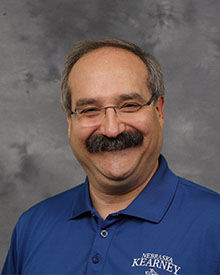History professor lectures on Iowa State’s football dominance in 1890s

Courtesy of the University of Nebraska-Kearney
Dr. Doug Biggs talked about Iowa State football in the 1890s at the Ames Public Library on March 28, 2017.
March 28, 2017
Iowa State football and winning haven’t gone together — at least in the last few years.
But, back in the late 19th century, Iowa State, known then as Iowa Agricultural College, the program was feared by opponents.
Guided by legendary coach Glenn “Pop” Warner, The Cyclones went 20-8 through the 1894-1897 seasons.
Arguably one of the Cyclone football program’s greatest season came in 1896, when it went 8-2, blowing out most opponents.
Douglas Biggs, a history professor at the University of Nebraska-Kearney and an Ames native, dove into the topic during a lecture at the Ames Public Library on Tuesday night.
Biggs started by telling the story of Iowa Agricultural College by going to Columbia, Missouri, on Friday, Oct. 2, 1896.
The Tigers were a powerhouse in the Midwest, and had not let an opponent score a single point on their home territory of Rollins Field.
The Cyclones dismantled the Tigers 12-0.
Many fans in attendance couldn’t believe that a small agricultural school’s team could outplay and be bigger in size than the Missouri players.
The Kansas City Star newspaper the Monday after put out an article accusing Iowa Agricultural College of paying professional athletes.
Biggs set out to answer the accusations posted by the Kansas City Star by looking at how Iowa State got so good at football.
He started with the arrival of William Beardshear in 1891. As president, Beardshear inherited a college that was in disarray and disconnected from the community of Ames.
Beardshear hired football coach to start a team.
“Beardshear knew that football was immensely popular, not only among student, but the general public,” Biggs said. “Fielding a winning college football team, even at this early point in the history of football, symbolized legitimacy for himself and his institution.”
Beardsheer later hired “Pop” Warner, who propelled the team to popularity. Audiences attended practices nightly, when Warner played in scrimmages himself.
Even the popular George Washington Carver couldn’t resist the football craze, as he served as an athletic trainer during his time in Ames.
Records showed that despite Iowa Agricultural College requiring players to be enrolled with 15 credit hours during a term, many times the Cyclones would not.
Of the 25 men that played during that period, only 11 met eligibility.
This was not uncommon for teams during the early days of football to enlist non-student players to play, Biggs said. Some players would only stay for a few games and move on.
“While other schools relied vagabond athletes to supplement their squads and bring them momentary flashes of glory,” Biggs said. “IAC found a core of players that stayed together and thus provided a rare blend that made IAC football a success.”
There are no financial records of players being paid, so there isn’t a way to truly know. Many could look at other teams from that era who did pay its players and note the similarities to the Cyclones.
Whether the Iowa State football program paid players in the 1890s is irrelevant to Biggs.
Biggs said that what really mattered was Iowa State had a core group of players that stuck together for four years and by doing so helped build the university into what it is today.















